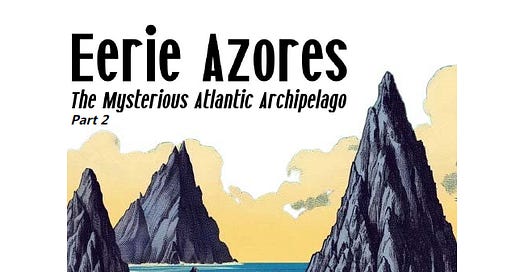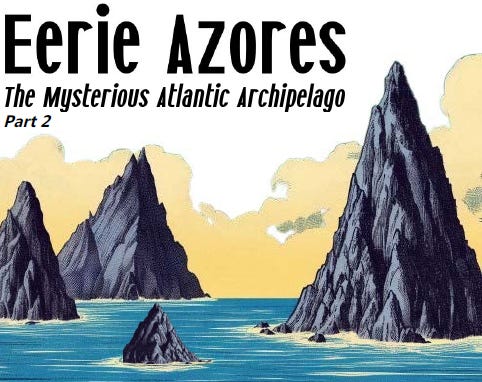In addition to overhead oddities, the Azores are also rumored to hide secrets beneath the waves.
Researchers digging for the fabled realm of Atlantis place the island chain high on their list of suspects. Not only is it in the general vicinity of where the sunken landmass is thought to exist based on Plato’s portrayal in Timaeus and Critias, but its unique geological features—including evidence of ancient volcanic activity and submerged structures—further enhance its status as a prime candidate.
Speculation that the islands might be the remains of the elusive continent initially emerged in the late 1600s, and Atlantologists have been fascinated with the tantalizing prospect ever since.1
American author and politician Ignatius Donnelly was one of the first to write extensively on the mythology and potential reality of a historical Atlantis in 1882. He imagined that the craggy highlands of the Azores were the “mountain peaks of this drowned island.”2 One-hundred years later, Charles Bertlitz’s Atlantis (1984) placed the legendary landmass somewhere in the same vicinity.
Plato’s retelling of the saga states that the advanced society was “swallowed up by the sea” after being roiled by earthquakes, a detail that lends credence to the possibility of Atlantis in the Azores.3 The islands are constantly besieged by unpredictable seismic and volcanic activity—just the sort of catastrophic conditions that could cause the “lost continent” to go missing. Mr. Fortean himself, Charles Fort, compiled several reports of “violent submarine eruptions” from the region in the 1800s.4
Accounts of megalithic structures submerged in the waters off the archipelago’s coast hint at the remains of a bygone society.
As recently as 2013, local sailor Diocleciano Smith became news when he stumbled upon what he believed to be a pyramidal object larger than a soccer field below the waterline. The eye-popping find was apparently passed on to the Portuguese authorities who denied that anything with those dimensions was located in the area. It’s worth noting that they didn’t go out and visually check the coordinates that Smith supplied, but rather consulted surveys conducted 4-years prior.5
While the thought of finding an ancient sunken empire is a romantic notion, formal archaeological, geological, and historical records don’t agree with the theory of an Azorean Atlantis. That hasn’t deterred an army of dedicated amateur investigators who continue to take up the mantle and focus their efforts on the Atlantic archipelago.
Back to the Holes
Turning our gaze back to the modern maritime mystery in the waters around the Azores: the riddle of the seafloor holes. The tiny punctures might not be as captivating as flying saucers or fragments of a lost civilization, but their explanation still escapes scientists. Experts have ruled out the organism behind similar- looking excavations documented in the Bering Sea. Those openings are much fewer and unevenly-spaced than the track-like divots found along the MAR. Researchers speculate that each formation likely has “a different maker,” but so far no candidates have been put forth.6
Chances are strong that they’re associated with a heretofore undiscovered creature. When considering the Atlantic’s unique abyssal habitat, oceanographer Dr. Kenneth Hinga suggested that the configurations might be evidence of organisms “strictly associated with the mid-ocean ridges.”7 Not quite a “cryptid” according to the textbook definition, but an exciting discovery all the same.
Perhaps some unfamiliar lifeform buries its eggs beneath the silt, and the offspring later free themselves by digging out after they hatch. Or maybe a bottom-feeding creature extends its proboscis into the seabed at regular intervals in an orderly search for food.
If the small perforations aren’t the byproduct of some unknown ocean-dweller, they could be evidence of a vast underground tunnel or cave system. As air or other gases seep out from subterranean caverns, some portion bubbles up through the sediment, leaving curious dots in the sand.
Or, it’s the last of the Atlanteans trying to communicate with us—making their holes a form of aquatic Morse Code that’s yet to be deciphered.
Dr. Michael Vecchione, a deep-sea biologist who has studied the enigmatic holes, summed up the spirit of the region nicely: “This highlights the fact that there are still mysteries out there.”8
Is this string of landforms piercing the Atlantic actually the summits of an antediluvian mountain range? Is there a UFO “window area” hidden in the clouds above the Azores archipelago? The islands don’t give up their secrets easily. Whatever the cause, the legendary islands and their location along the Mid-Atlantic Ridge remain a nautical hotbed of high strangeness.
















Another great article, don't know how I missed Pt.1 though.
I'm always down for some Ignatius Donnelly!